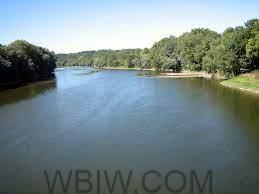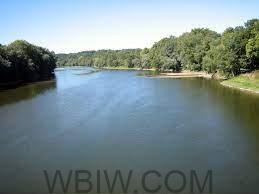
EVANSVILLE – The crescent-shaped oxbow lakes along the Wabash River in southwestern Indiana seem simple enough, yet these lakes are great research sites for scientists. The oxbow lakes of the lower Wabash and White rivers provide important habitats for river fish, many of which use these lakes as nurseries for their young. Most of these species have declined or disappeared from Midwestern rivers over the last hundred years.

The Nature Conservancy (TNC) wants to know how oxbow lakes can help increase their numbers, as well as the role of oxbow lakes in its freshwater conservation strategies. Support from Toyota Motor Manufacturing, Indiana has allowed TNC to delve more deeply into oxbow lakes.
Oxbow lakes form as river meanders and create large bends in the channel, which are eventually cut off from the river. In time, sediments fill in the upstream and downstream ends of the bend, creating a horseshoe-shaped body of water. Oxbow lakes present a rare opportunity to conserve a piece of Indiana’s natural history, as well as help many fish species in decline.

With support from Toyota Indiana, TNC has worked with researchers to determine where protection and restoration efforts will have the greatest impact. These efforts include reducing the amount of nitrogen, phosphorus and sediment entering the waterways and planting trees to provide natural filtration along the shorelines. In addition, Toyota Indiana’s support has allowed TNC to continue monitoring the oxbow lakes that represent areas with high potential for conservation and develop strategies to incorporate oxbow lakes into healthy floodplain conservation.
“Toyota Indiana has been a dedicated supporter of TNC’s work in southwest Indiana for many years, and we are proud to call them a partner,” said Brad Smith, lower Wabash River program director for TNC. “Their support has generated real results for clean water in Indiana.”
TNC has been working with scientists at Bellarmine University, Ball State University, Purdue, University, and IUPUI to better understand how these lakes function in the floodplain. The ultimate goal of this work is to improve habitat quality in and around the lakes and to understand how floodplain restoration work impacts the ecology of the Wabash and greater Mississippi River basin.
TNC and partners have submitted a manuscript of their oxbow lake findings for publication as a research article in River Research and Applications. The soon-to-be-published paper reveals that land use in the land immediately around the lakes plays an important role in the quality of habitat in the lakes, which impacts fish diversity. These findings suggest that protection of habitat and/or encouraging the use of Best Management Practices in agricultural lands can have a positive impact on fish habitat by improving water quality in the lakes.
Toyota Indiana’s support has also funded several events geared toward farmers, landowners and partners interested in improving conservation practices. The upcoming November 6 event open to all is Regenerative Ag Forum: Next Steps for Soil Health & Climate Mitigation, where experts will discuss soil health, reducing crop costs and fertilizer run-off, building resilience to extreme weather events and moderating climate change.



